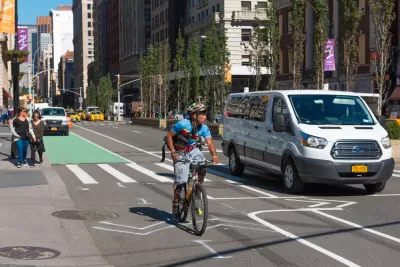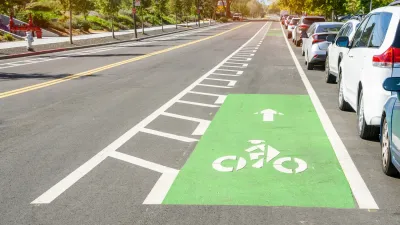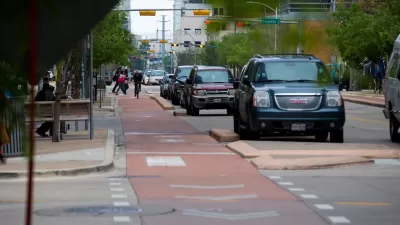Some research suggests that separated and even ‘protected’ bike lanes actually increase the likelihood of car-bike collisions.

After a U.S. State Department foreign service officer died after being hit by a vehicle while riding her bicycle, Diana Furchtgott-Roth of Forbes poses the argument that painted and protected bike lanes could actually raise the risk of crashes.
“The National Highway Traffic Safety Administration estimates that 938 cyclists were killed on the roads in 2020, the latest available data. That’s up by 9 percent from 2019 and the highest number since 1987,” Furchtgott-Roth writes, arguing that bike lanes are “not a safe space” for people on bikes because “it’s impossible to structure bike lanes without vehicles turning into these lanes to get to underground garages, above-ground parking lots, and to make right or left turns at intersections.”
Furchtgott-Roth points to a paradox “originally described by industrial engineer John Forester in his 800-page book Effective Cycling, which boasted seven editions (MIT Press, 2012),” which states that protected bike lanes are more dangerous than shared normal roads. Forester “forecast more car-bike collisions, because it is difficult to make intersections between cycle lanes and roads as safe as normal roads.”
Other studies also find that bike lanes increase the chance of crashes compared to shared roadways. One Colorado study “concluded that separated bike lanes raise the number of crashes by 117 percent compared with shared roadway.” Jan Heine, editor-in-chief of Bicycle Quarterly, wrote “On streets with frequent intersections, separate paths only make cycling less safe.”
According to the article, “In many urban settings the safest place for a bike is in the middle of a car lane, with bike lights and a helmet lamp for the rider, cycling behind vehicles rather than beside them.” This must be coupled, of course, with robust driver education that, essentially, changes America’s driving culture toward an ethos of sharing the road. “All states need to educate drivers, as part of driving tests, to treat cyclists respectfully, just as they treat other vehicles respectfully.”
FULL STORY: Bike Lanes Don’t Make Cycling Safe

Maui's Vacation Rental Debate Turns Ugly
Verbal attacks, misinformation campaigns and fistfights plague a high-stakes debate to convert thousands of vacation rentals into long-term housing.

Planetizen Federal Action Tracker
A weekly monitor of how Trump’s orders and actions are impacting planners and planning in America.

In Urban Planning, AI Prompting Could be the New Design Thinking
Creativity has long been key to great urban design. What if we see AI as our new creative partner?

Florida Seniors Face Rising Homelessness Risk
High housing costs are pushing more seniors, many of them on a fixed income, into homelessness.

Massachusetts Budget Helps Close MBTA Budget Gap
The budget signed by Gov. Maura Healey includes $470 million in MBTA funding for the next fiscal year.

Milwaukee Launches Vision Zero Plan
Seven years after the city signed its Complete Streets Policy, the city is doubling down on its efforts to eliminate traffic deaths.
Urban Design for Planners 1: Software Tools
This six-course series explores essential urban design concepts using open source software and equips planners with the tools they need to participate fully in the urban design process.
Planning for Universal Design
Learn the tools for implementing Universal Design in planning regulations.
Gallatin County Department of Planning & Community Development
Heyer Gruel & Associates PA
JM Goldson LLC
City of Camden Redevelopment Agency
City of Astoria
Transportation Research & Education Center (TREC) at Portland State University
Jefferson Parish Government
Camden Redevelopment Agency
City of Claremont





























